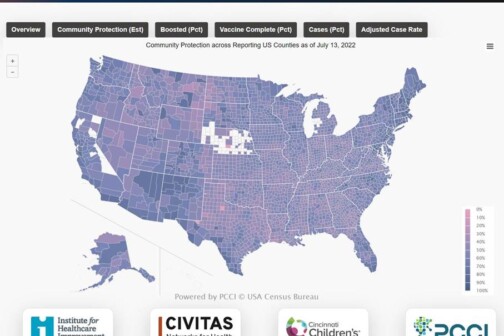Last week, I checked in on the CDC’s wastewater surveillance data and noticed that the COVID-19 prevalence in Dallas’ sewershed had jumped 100 percent in the previous two weeks. The little red dot on the map looked like a warning beacon for yet another wave. Was there a new variant? A new strain that was super contagious?
The wastewater data has become important for a few reasons. First, COVID-19’s presence in sewage usually predates the public’s awareness of the infection, often showing up in our waste before we have symptoms. In addition, at-home testing and COVID-19 fatigue mean that the daily case count from the county health authorities is deflated relative to the actual amount of COVID-19 in the community. The wastewater data is considered a quicker and more objective measure of the virus’ spread. Unless it isn’t.
After seeing the big jump for the Dallas sewershed, I checked in with Dr. Philip Huang, the Medical Director for Dallas County, which is working with Dallas Water Utilities and the CDC to measure the COVID-19 in the wastewater and get a jump on any public health measures that can help stem the spread.
Huang had good news to report about the jump in COVID-19, which is primarily a math issue. Dallas County started measuring the wastewater later than most other places, which means there are fewer data points, to begin with. Dallas didn’t start measuring the wastewater as soon as other places, which means that percentage swings are more likely.
In addition, Dallas has a lower case rate than it did at other points during the pandemic, so a slight increase in cases can cause a significant swing in terms of the rate. Huang said that cases haven’t jumped up significantly, so the percentage jump has more to do with low baseline data than any jump in COVID-19 prevalence, Huang says.
“There is no cause for alarm. The data are still evolving,” Huang says. “There are still limited data, and it’s still evolving.”
Huang says COVID-19 hospitalizations are still low, and the county is nearing moving the threat level back to green, though all the indicators aren’t low enough yet. Even though he is seeing some growth in the omicron subvariant, the overall numbers are still low. If we see a significant jump later this year once we have more data, that could be cause for concern, but things seem to be pretty stable now.
“There is a slight increase in cases, but folks should not panic, but be watchful,” says Steve Miff, CEO and President of the Parkland Center for Clinical Innovation. “Increases are expected given the increase in BA.2 prevalence and what we’re observing in the other regions.”
Dallas County hospitals have just 73 people hospitalized with COVID-19, and only 13 patients are in the ICU with COVID-19. right now, 70.7 percent of the total population has received at least one vaccination, with 50.8 percent fully vaccinated, according to PCCI.
Hopefully, we won’t need to be checking any COVID-19 indicators in the coming months, but Huang says it should be more accurate at that point, should we need it. The good news is that the indicator is already back down to a 20-39 percent rise, rather than the more alarming 100 percent rise. Huang says patients and calm are the guidance for now. “I wouldn’t over-read the data.”
Get the D CEO Healthcare Newsletter
Author






